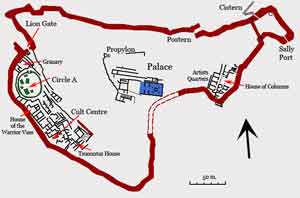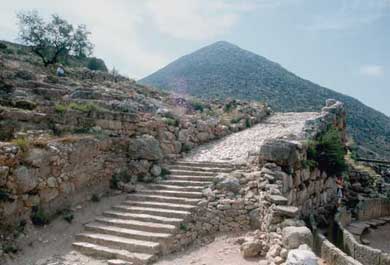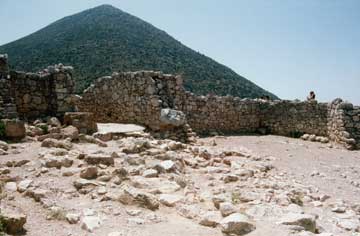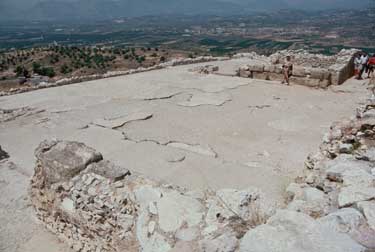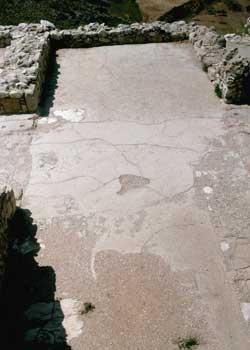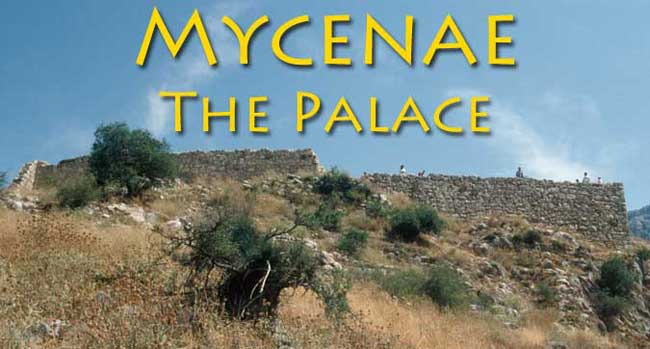
The main approach to the palace is the Great Ramp which begins at the back end Inner Court, just beyond the Lion Gate. It is between 4 and 5.75 metres wide, paved with cobbles and buttressed by a large retaining wall. It runs southwards for 24 metres before turning to the east at a landing part way up the hill. After about 30 metres it branches— one fork leading 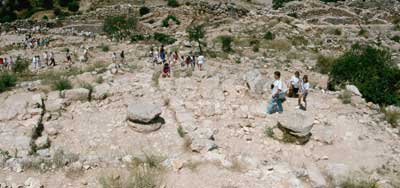 to the Propylon of the palace and the other to the Grand Stairway.
to the Propylon of the palace and the other to the Grand Stairway.
The Palace itself was built on the summit and along massive terraces on the south-western and eastern slopes of the hill. A modern reconstruction of the terracing can be seen in the title shot of this page. The official entrance was via an H-shaped Propylon (left) of the sort found at Pylos and Tiryns— 2 single-columned, roofed porticoes back-to-back (marked A on the plan below). From a small court beyond, a passage leads to the rest of the palace. On the left was a small flight of stairs that led up to the private apartments of the palace. Unfortunately, any trace of these was all but obliterated by the construction of a classical temple dedicated to Hera or Athena on the site and subsequent erosion of the hilltop.
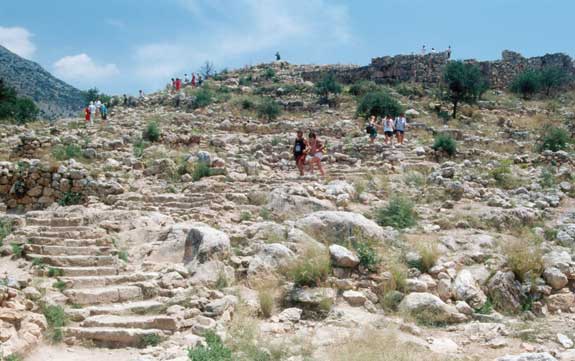
From the top of the Great Ramp to the Palace Terrace
A large stone threshold is all that remains of the West Portal (B), the entrance to the more formal parts of the building. Just to the north is a small room which may have served as a guardroom. Unfortunately, any rooms to the south have long since disappeared down the hill when the original terrace collapsed. What is visible of the terrace today has largely been restored in order to prevent the loss of what remains of the buildings on top.
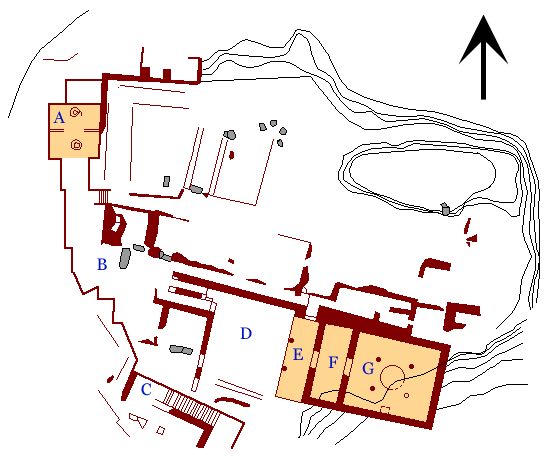
Plan of the Palace
Beyond the West Portal was a small court with a pair of passageways leading off— one to the domestic apartments at the top of the hill and the other to the throne room suite. To the south of the court was the Grand Staircase (C), which led directly from the palace to the Cult Centre and was undoubtedly the scene of great ceremonial processions. At the far side of the court was a suite of rooms, possibly a set of guest rooms or offices for palace officials. The Forecourt (D), which measured 11 x 15 metres, was reached directly from the second passage and is reasonably well-preserved. The upper surface had originally been plastered and divided into painted squares, similar to the decoration of the palace floors at Pylos.
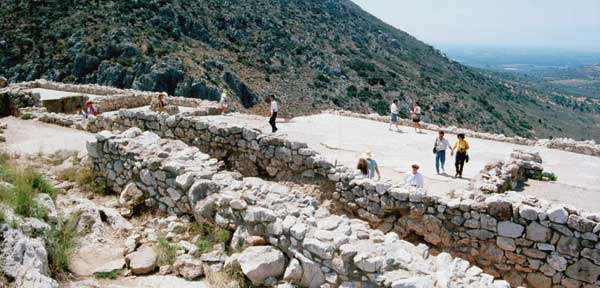
Overall View of the Palace
On the east side was a megaron of identical design to those found at the other palaces. Facing the court was a covered Portico (E), paved with gypsum slabs and with painted plaster walls. There is a threshold at the north end of the room, indicating that a doorway once led from there to the upper passageway and the domestic apartments. Part of the base of a stone altar was found near one of the column bases along with a basin for pouring libations. The antechamber was also decorated with frescoes but they had been severely damaged by the fire that eventually destroyed the palace and only tiny fragments have survived. The main room measured 12.95 x 11.5 metres but, like the antechamber, was badly eroded on the south side where a sizeable chunk of the original terrace had crumbled away. 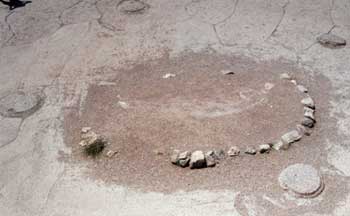 Nevertheless, it is obvious that it had more or less the same layout as those at Tiryns and Pylos. In the centre was a circular hearth (d=3.4 metres) built of a heavily plastered ring of stones and surrounded by 4 wooden columns on stone bases— the same arrangement as at Pylos. The lower part of the walls were covered with gypsum slabs, with frescoes above, while the floor was of stucco, divided by painted lines into squares. The throne, on analogy with the better preserved palaces, presumably sat against the southern (right-hand) wall. There is no evidence of a second storey (at least there are no staircases) or of any balcony such as there was at Pylos.
Nevertheless, it is obvious that it had more or less the same layout as those at Tiryns and Pylos. In the centre was a circular hearth (d=3.4 metres) built of a heavily plastered ring of stones and surrounded by 4 wooden columns on stone bases— the same arrangement as at Pylos. The lower part of the walls were covered with gypsum slabs, with frescoes above, while the floor was of stucco, divided by painted lines into squares. The throne, on analogy with the better preserved palaces, presumably sat against the southern (right-hand) wall. There is no evidence of a second storey (at least there are no staircases) or of any balcony such as there was at Pylos.

